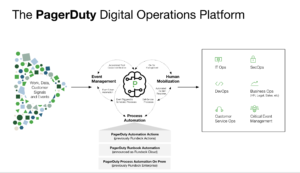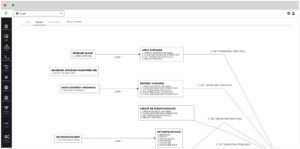- PagerDuty /
- Blog /
- Automation /
- PagerDuty® Runbook Automation Joins the PagerDuty Process Automation Portfolio
Blog
PagerDuty® Runbook Automation Joins the PagerDuty Process Automation Portfolio
Spring is blooming here at PagerDuty, and so is our automation product line. We’re thrilled to share some exciting product announcements.
First, we’ve officially rebranded our automation product line, Rundeck®, as PagerDuty® Process Automation. Fundamentally, everyone who buys Rundeck becomes a PagerDuty customer, so we decided to make it less confusing.
Second, our runbook automation cloud service (announced last fall as “Rundeck Cloud”) is now generally available. This was included in the rebrand, so we chose to name it according to what it does: “PagerDuty Runbook Automation.” PagerDuty Runbook Automation is a SaaS-based offering within our PagerDuty Process Automation portfolio that’s designed to automate operations procedures so that a wider range of people in an organization can utilize them.
Finally, we are announcing version 4.0 of Rundeck Enterprise, which will now be known as “PagerDuty Process Automation On-Prem.” PagerDuty Process Automation On-Prem is self-managed software that supports a wide range of process automation use-cases.
Let’s get into the details:
Rundeck Is Now “PagerDuty Process Automation”
As mentioned above, the Rundeck product line has been rebranded as PagerDuty Process Automation. Since the acquisition of Rundeck, we’ve seen rapidly growing demand for the product from both existing PagerDuty customers and the Rundeck community. PagerDuty has also released multiple new products related to Rundeck, providing seamless integration with PagerDuty Incident Response (now called PagerDuty Automation Actions) and now a SaaS version of Rundeck focused on the runbook automation use case (now called PagerDuty Runbook Automation).
The vision behind PagerDuty Process Automation is to help our customers automate everything in their businesses, drive up consistency, and drive down resolution times. PagerDuty Process Automation empowers customers to automate IT and business procedures across their business systems. These processes can then be safely delegated to stakeholders, run on a scheduled basis, or triggered in response to events.

These automated processes can be used to diagnose and remediate issues, fulfill service requests, and conduct regular maintenance and administrative tasks. These actions can be human-assisted, or executed without any manual intervention.
The PagerDuty® Process Automation portfolio consists of the following offerings:
- PagerDuty® Automation Actions. A PagerDuty add-on that curates and connects responders in PagerDuty to automated diagnostics and remediation for services involved in incidents.
- PagerDuty® Runbook Automation. A SaaS service that enables engineers to standardize and automate runbook procedures, and delegate services as self-service operations.
- PagerDuty® Process Automation On-Prem. A self-hosted software cluster that gives engineers the ability to standardize and automate end-to-end operational workflows, and safely delegate them as self-service operations to stakeholders.
Runbook Automation is Generally Available
PagerDuty Runbook Automation gives you powerful runbook automation without needing to install and manage the automation software yourself. Why is this useful? Let’s look at how cloud computing services themselves get provisioned and managed. Cloud computing is powerfully easy. With the press of the button, users can spin up nearly any kind of IT service. Despite the fact that the cloud provides a lot of powerful technical automation, this automation is not considered safe to make broadly available to all potential users. The reasons for limiting access include concerns about cost, speed of outcome, quality of operations, and security.
To mitigate this limited access, companies resort to having their engineers and stakeholders submit tickets to centralized cloud infrastructure teams for their needs. These infrastructure teams can keep track of all cloud usage, have the skills to properly set up and operate cloud services, and are able to enforce policies and ensure secure operations. However, a task that could take minutes to spin up in the cloud automatically ends up taking days to be manually fulfilled by the central cloud team.
What companies really need to do is build automation for fulfilling those tasks, and make them available to the humans that need them. In other words, automate their runbook procedures, and then delegate this automation to stakeholders.
Using PagerDuty Runbook Automation (previously announced as Rundeck Cloud), Users turn manual runbooks into delegated, self-service requests and automate key IT tasks across environments to optimize security and compliance. This can include automating runbooks for resolving incidents, closing tickets, and fulfilling requests, now with the agility of operating in the cloud.
As a SaaS-based offering, PagerDuty Runbook Automation lets DevOps engineers and SREs get started immediately. They can deliver reliable, automated processes that are highly secure and available without having to manage automation infrastructure.

PagerDuty Runbook Automation
Engineers standardize task automation for any public cloud. They do so by defining jobs that incorporate common infrastructure components as nodes and executing steps that utilize existing scripts and commands. PagerDuty Runbook Automation facilitates the delegation of these jobs by ensuring safety and compliance with authentication, access control, and privileged access management services—and by logging every activity.
PagerDuty Runbook Automation connects automation in customers’ production environments via an agent called a Runbook Runner that is deployed behind the firewall. It securely connects nodes within their environments back to the PagerDuty Runbook Automation endpoint. These nodes can then be used to execute steps in automated process jobs. Job definitions can incorporate nodes connected by different Runbook Runners.
The PagerDuty Runbook Runner is built to meet the latest zero-trust security models. It calls back to the PagerDuty Runbook Automation endpoint via HTTPS. There’s no need to open additional ports in firewalls.
Some of the use cases we’ve seen early users utilize PagerDuty Runbook Automation for include:
- Providing self-service cloud operations for end-users like developers and customer service agents. Developers no longer need to wait for their environments, while platform teams see fewer tickets and interruptions.
- Simplified management of multiple cloud accounts. It can be difficult to manage many accounts across multiple public clouds. PagerDuty Runbook Automation simplifies the sharing of access credentials in the context of operational processes.
- Tracking of automation for auditing and compliance. When users are managing hybrid environments, it can be difficult to track down all the automation logs across cloud accounts and other tools. All jobs are logged and easily viewable in PagerDuty Runbook Automation, making audit tracking seamless.
Process Automation On-Prem 4.0 Now Available
We’re also excited to announce Version 4.0 of PagerDuty Process Automation On-Prem (previously Rundeck Enterprise). Version 4.0 rolls up security, stability, and usability enhancements, and includes a version of the Runner technology used by PagerDuty Runbook Automation—in this case, a Process Runner.
The Process Runner allows customers to run automated jobs that span between trusted environments. Customers can complete multi-environment changes, such as patching software instances in different data centers or availability zones, through automation in minutes instead of manual procedures that can take days.
The Process Runner deploys behind firewalls in disparate environments. It securely connects nodes within these network segments back to the central PagerDuty Process Automation On-Prem cluster. These disparate nodes can then be used to execute steps in automated process jobs that span across multiple environments.
The Process Runner is built to meet the latest zero-trust security models. It calls back to the PagerDuty Process Automation On-Prem cluster endpoint via HTTPS. Now there’s no need to open additional ports in firewalls.
PagerDuty Process Automation On-Prem’s security model allows companies to eliminate the need to support SSH between their trusted zones. This update is especially useful for businesses that need to better support automation of IT processes at subsidiaries and acquired companies, automate across global geography, and optimize the separation of customer data.
We love our Rundeck customers and look forward to continuing the journey together. Sign up for the PagerDuty Process Automation Launch Webinar to learn more!


